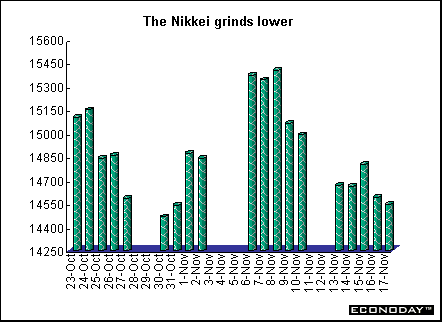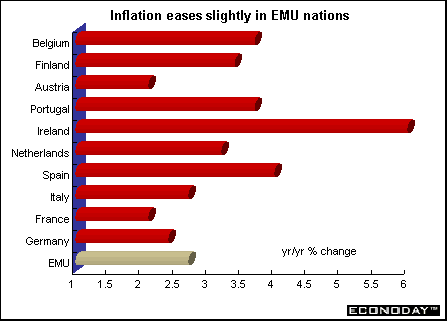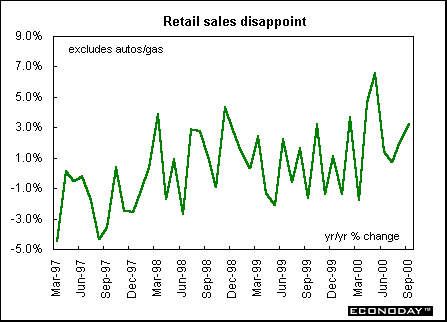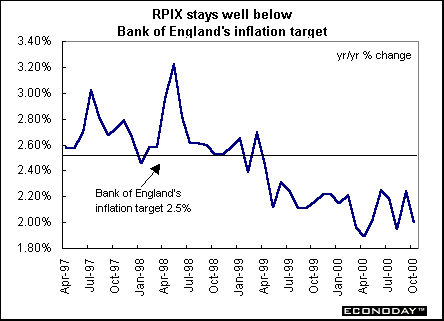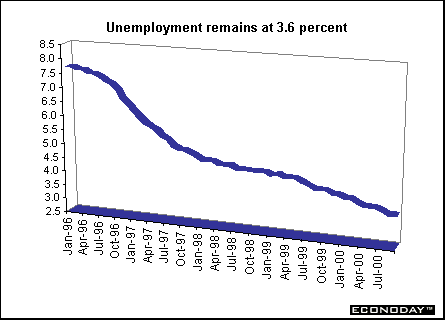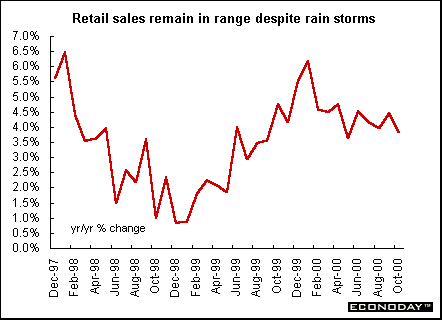| Previous Articles |
|
The prospects of lower earnings growth continue to rattle equities markets. Investors always have difficulty adjusting earnings expectations downward - especially from the spectacular high teens to the not too shabby high single digit increases that are anticipated. Most overseas markets ended the week on the down side, with technology stocks bearing the brunt of investor frustrations. And underlying political uncertainties didn't help. Investors are more concerned about Monday's no confidence vote in Japan than they are about the yet undecided U.S. election. And in Canada, Prime Minister Jean Chrétien called a snap election to consolidate his position for November 27. In the foreign exchange markets where political uncertainties get more attention, the dollar remains strong. The euro could not take advantage of the U.S. political situation. However, if the growth differential is truly the reason for the disparity between the euro and dollar, economic data last week did not bolster hopes that the growth gap between the United States and the European Monetary Union would narrow. Weak data in Germany and Italy especially, indicated that EMU growth is slowing also. The Bank of Japan voted to keep interest rates unchanged amid concerns that slowing global growth would hurt the nation's exporters. Consumers have not stepped in to fill the void but continue to keep a tight rein on spending. The benchmark Nikkei 225 index continues to erode and its loss for the year - now 23.2 percent - threatens to dampen investor and consumer confidence further, clouding the economy's outlook. Oil prices and production levels took on added meaning as the weather took on a decided chill. Crude oil rose to $35.45 per barrel on the NYMEX after OPEC left production levels fixed for the rest of the year.
Europe and Britain
In Britain, the many policy making economic indicators (see indicator scoreboard below) and the Bank of England's quarterly inflation report were ignored as the markets remained riveted by earnings failures, slower growth and political instability in Japan and the United States. The FTSE inched up 39.9 points or 0.62 percent to end the week at 6440.10. The Paris CAC managed to eke out a 14.43 point or 0.23 percent gain to end the week at 6161.92. The DAX, however, was down 99.40 points or 1.45 percent on the shakeup at DaimlerChrysler. It ended the week at 6752.29. Asia
The Nasdaq's declines have a psychological impact on overseas investors. Investors look at the Nasdaq first when deciding their technology trades elsewhere. The ongoing U.S. downgrades continue to have an impact in Asia. Many of the Asian chipmakers haven't addressed profit downgrades yet. And high inventories could be a problem, leading to fewer orders for semiconductors in the near term. In Japan, the markets have been diverted by record bankruptcies (see indicator scoreboard below), the faltering chip market, and the government crisis facing prime minister Mori. With his approval rating at an all time low and slipping (18 percent), he is being challenged by a no confidence vote on Monday. He is expected to lose, forcing him to disband his cabinet or call early parliamentary elections if he cannot get the Liberal Democratic Party to support a cabinet reshuffle. Currencies
Several traders have expressed concern at the euro's inability to garner any support from the uncertainty surrounding the U.S. political process. The euro is down by default and the single currency finds few new friends in a market unwilling to buy the currency without the encouragement of central bank supportive intervention. The yen, unlike the dollar, fell against most major currencies because of a political dispute that could lead to a change in government. The losses came after Prime Minister Yoshiro Mori was asked to step down by a member of his own Liberal Democratic Party, Koichi Kato, following a series of scandals among Mori appointees and gaffes by the prime minister. Traders were reluctant to make big bets on the currency while a political showdown unfolds. Some investors are concerned the battle for power within Japan's ruling party will distract the government from efforts to revive the economy.
Lingering concerns over the health of the Japanese economy amid rumors of more corporate bankruptcies and life insurer insolvencies also weighed on the yen. The Japan Center for Economic Research, a respected think tank, forecast that the Japanese economy might have shrunk by 0.5 percent in the July to September quarter from the previous quarter. The last time the economy posted a quarter-to-quarter decline was the fourth quarter of 1999. Indicator scoreboard
Germany - September real seasonally adjusted retail sales sank 1.7 percent but rose 1.4 percent when compared with last year. Excluding autos and gasoline, retail sales slipped 1.9 percent but were 3.2 percent higher than last year.
October wholesale prices rose 0.2 percent and 7.4 percent from a year earlier. This was the biggest annual increase since February 1982. Heavy heating oil, citrus fruits and copper products led the increases. Upward pressure is coming not only from oil prices but also from other goods, a sign of indirect effects stemming from the weak euro and high oil prices. France - October seasonally adjusted consumer prices slipped 0.1 percent but rose 2.0 percent when compared to last year. The decline was mainly due to cuts in energy taxes. The core inflation rate, which excludes administered prices and volatile sectors like food and energy, rose 0.2 percent and 1.3 percent when compared with last year. September trade balance rose E54 million after two months of deficit. Seasonally adjusted exports declined by 3.5 percent while imports dropped 5.0 percent. Third quarter exports were down 1.1 percent from the second quarter but were 9.7 percent higher on the year. Third quarter imports were up 3.6 percent and 19.9 percent higher on the year. Italy - Third quarter seasonally adjusted preliminary third quarter real gross domestic product climbed 0.5 percent and 2.4 percent when compared with last year. The third quarter preliminary data were released particularly early (just 45 days after the reference period's end) and are expected to be subject to more revisions than usual. Today's numbers were eagerly awaited as the first preliminary GDP data to be released by a large EMU country. September seasonally and workday adjusted industrial production was unchanged. Workday adjusted output posted a gain of 5.1 when compared with last year. Spain - October consumer prices climbed 0.3 percent largely on rising fuel prices and 4.0 percent when compared to last year. This is the highest rate in five years. Core inflation rate rose 2.8 percent when compared with last year. Much of the rise in headline inflation was linked to oil prices. Energy product prices rose 1.5 percent and 13.8 percent when compared with last year. Britain - October seasonally adjusted producer input prices fell 0.9 percent and soared 12.2 percent when compared with last year. The drop was driven mostly by lower crude oil prices. On an unadjusted basis, these were down 5.4 percent on the month but still up 56.9 percent on a year earlier. October imported materials prices fell 1.2 percent - the largest decline since April 2000 - as the exchange rate index appreciated by 2.9 percent over the month. Non-seasonally adjusted output prices rose by 0.1 percent and 2.6 percent when compared with last year. Seasonally adjusted core output price inflation rose 0.1 percent and 1.0 percent on the year. October retail price index fell 0.1 percent but rose 3.1 percent when compared with last year. The RPIX, which excludes mortgage interest payments, also fell 0.1 percent but rose 2.0 percent when compared with last year. The RPIY, which excludes both mortgage interest payments and indirect taxes, also fell 0.1 percent on the month and was up 1.6 percent on the year.
October unemployment rate remained at 3.6 percent. However, claimant count unemployment rose 3,500 - the first rise since November 1998. Unemployment on the International Labor Organization measure for the three months to September fell 36,000 when compared with the previous quarter. The rate fell back to 5.4 percent from 5.5 percent in the previous three months.
September seasonally adjusted average earnings were up 4.3 percent when compared with a year earlier. In the three months to September average earnings rose 4.1 percent from a rate of 4.0 percent in the previous three months. Earnings growth in the manufacturing sector remained unchanged at 4.3 percent while it rose to 4.0 percent in the service sector from 3.8 percent in August. Earnings growth in the public sector fell back to 3.3 percent from 3.5 percent in August while that in the private sector rose to 4.3 percent from 4.1 percent.
October seasonally adjusted retail sales volumes were unchanged but were 3.8 percent higher when compared with last year. Sales for the three months to October rose 1.2 percent and 4.1 percent on the same period a year earlier. Particularly notable in October was a further strong rise in the clothing and footwear category, up 1.8 percent on the month after September's 1.2 percent gain. Household goods sales rose by 0.2 percent on the month and non-specialized stores were up 0.3 percent.
Asia September revised industrial production fell 3.4 percent but rose 3.9 percent when compared with last year. Shipments declined 3.6 percent but increased 4.2 percent on the year. Inventories were revised to a drop of 1.0 percent and were down 0.3 percent on the year. October corporate bankruptcies rose 22.7 percent from a year earlier and debts left behind by insolvent companies surged 1,253.4 percent to a new post-war high as two mid-sized life insurance companies failed. The number of October cases rose 13.9 percent from September to 1,711 and the amount of debt was up 1,005.8 percent. October also marked another post-war record for the highest percentage of bankruptcies resulting from sluggish economic conditions. Foreign direct investment hit a record high for the first half of the fiscal year ending September 30, underscoring the unprecedented pace at which overseas buyers are taking stakes in corporate Japan. Foreign direct investment rose 42.1 percent when compared with the year earlier period. The bulk of that investment - 40.5 percent - was into financial service concerns. Americas BOTTOM LINE
Release dates are subject
to change. |
||||||||||||||||||||||||||||||||||||||||||||||||||||||||||||||||||||||||||||||||||||||||||||||||||||||||||||||||||||||||||||||||||||||||||||||||||||||||||||||||||||||||||||||||||||||||||||||||||||||||||||||||||||||||||||||||||||||||

